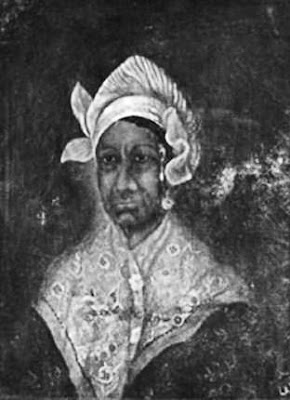Voodoo & Tignon Laws
in Louisiana
.During the 19th century, Marie Leveau (d. 1881), a devoted Catholic known as the Voodoo Queen, was generally a feared figure in New Orleans. Though apparently adept with Voodoo charms & potions of all kinds, Marie's real power came from her extensive network of spies a& informants. The New Orleans elite had the careless habit of detailing their most confidential affairs to their slaves & servants, who then often reported to Marie out of respect & fear. As a result, Marie appeared to have an almost amazing knowledge of the workings of political & social power in New Orleans, which she used to build her power as a voodoo priestess.
In this portrait Marie Laveaux of New Orleans, Marie was depicted wearing a tignon. A tignon is a series of headscarves or a large piece of material tied or wrapped around the head to form a kind of turban resembling a West African gélé.
It was the mandatory headwear for Creole women in Louisiana during the Spanish colonial period, and the style was adopted throughout the Caribbean island communities as well. This headdress was required by Louisiana laws in 1785. Called the tignon laws, they prescribed appropriate public dress for females of color in colonial society, where some women of color & some white women tried to outdo each other in beauty, dress, ostentation and manners.
In an effort to maintain class distinctions in his Spanish colony at the beginning of his term, Governor Esteban Rodriguez Miró (1785 - 1791) decreed that women of color, slave or free, should cover their heads with a knotted headdress and refrain from "excessive attention to dress."
But the women, who were targets of this decree, were inventive & imaginative with years of practice. They decorated their mandated tignons, made of the finest textiles, with jewels, ribbons, & feathers to once again outshine their white counterparts.Extramarital relationships between French & African settlers, occuring since slaves arrived in New Orleans about 1719, had evolved into an accepted social practice. The custom of freeing the children of such unions; the right of slaves to purchase their freedom; the policy of liberating enslaved workers for excellent service; and the arrival of free people of color from Haiti, Cuba & other Caribbean colonies led to the rise of a vocal free black population.
Through inheritance, military service, and a near monopoly of certain skilled trades, free blacks acquired wealth & social status.
By the time Thomas Jefferson arranged for the Louisiana Purchase in 1803, New Orleans free blacks constituted nearly 20% of the city, while enslaved Africans comprised about 38% of the residents.
Women of color, slave & free, continued to wear their bright tignons well into the 19th century, and they continued to attract the attention of men regardless of class or color.
1786 Francois Beaucourt, Portrait of Servant Woman. McGill University, Montreal, Quebec, Canada.
1796 Thomas Rowlandson. Rachel Pringle of Barbados. Published by William Holland (London, 1796); Barbados Museum.
.Women of Santo Domingo in Tignons. www.slaveryimages.org, sponsored by the Virginia Foundation for the Humanities & the University of Virginia Library.
Woman Wearing Red Tignon with Bag of Laundry. The Lewis Walpole Library, Yale University.
19th Century Tignon Wearing Women of Color. www.slaveryimages.org, sponsored by the Virginia Foundation for the Humanities & the University of Virginia Library.

Woman in Tignon Selling Fruits & Vegetables. The Lewis Walpole Library, Yale University.
19th Century Mulatto Women and Tignons. www.slaveryimages.org, sponsored by the Virginia Foundation for the Humanities & the University of Virginia Library.
19th Century Caribbean Island Women in Tignons. www.slaveryimages.org, sponsored by the Virginia Foundation for the Humanities & the University of Virginia Library.





